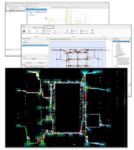RISC-V tends to generate excitement over the possibilities for the processor core, any custom instruction extensions, and its attached memory subsystem. Those are all necessary steps to obtaining system-level performance. But is that attention sufficient? Architects who have ventured into larger system-on-chip (SoC) … Read More
Pairing RISC-V cores with NoCs ties SoC protocols together
Designers have many paths for differentiating RISC-V solutions. One path launches into various RISC-V core customizations and extensions per the specification. Another focuses on selecting and assembling IP blocks in a complete system-on-chip (SoC) design around one or more RISC-V cores. A third is emerging: interconnecting… Read More
#60DAC Update from Arteris
I met up with Andy Nightingale, VP Product Marketing and Michal Siwinski, Chief Marketing Officer of Arteris at #60DAC for an update on their system IP company dealing with SoCs and chiplet-based designs. SemiWiki has been blogging about Arteris since 2011, and the company has grown enough in those 12 years to have an IPO, see their… Read More
Back to Basics – Designing Out PPA Risk
I wrote earlier about managing service-level risk in SoC design, since the minimum service level a system can guarantee under realistic traffic is critical to OEM guarantees of dependable system performance. An ABS design which might get bogged down in traffic under only 0.1% of scenarios is of no use to anyone. That said, meeting… Read More
Managing Service Level Risk in SoC Design
Discussion on design metrics tends to revolve around power, performance, safety, and security. All of these are important, but there is an additional performance objective a product must meet defined by a minimum service level agreement (SLA). A printer display may work fine most of the time yet will intermittently corrupt the… Read More
Is Your Interconnect Strategy Scalable?
“Strategy” is a word sometimes used loosely to lend an aura of visionary thinking, but in this context, it has a very concrete meaning. Without a strategy, you may be stuck with decisions you made on a first-generation design when implementing follow-on designs. Or face major rework to correct for issues you hadn’t foreseen. Making… Read More
Interconnect Under the Spotlight as Core Counts Accelerate
In the march to more capable, faster, smaller, and lower power systems, Moore’s Law gave software a free ride for over 30 years or so purely on semiconductor process evolution. Compute hardware delivered improved performance/area/power metrics every year, allowing software to expand in complexity and deliver more capability… Read More
Physically Aware NoC Design Arrives With a Big Claim
I wrote last month about physically aware NoC design, so you shouldn’t be surprised that Arteris is now offering exactly that capability 😊. First, a quick recap on why physical awareness is important, especially below 16nm. Today, between the top level and subsystems a state-of-art SoC may contain anywhere from five to twenty … Read More
Taming Physical Closure Below 16nm
Atiq Raza, well known in the semiconductor industry, has observed that “there will be no simple chips below 16nm”. By which he meant that only complex and therefore high value SoCs justify the costs of deep submicron design. Getting to closure on PPA goals is getting harder for such designs, especially now at 7nm and 5nm. Place and… Read More
Arteris IP Acquires Semifore!
The semiconductor ecosystem consolidation continues with an interesting acquisition of an EDA company by an IP company. Having worked with both Arteris and Semifore over the past few years I can tell you by personal experience that this is one of those 1+1=3 types of acquisitions, absolutely.










